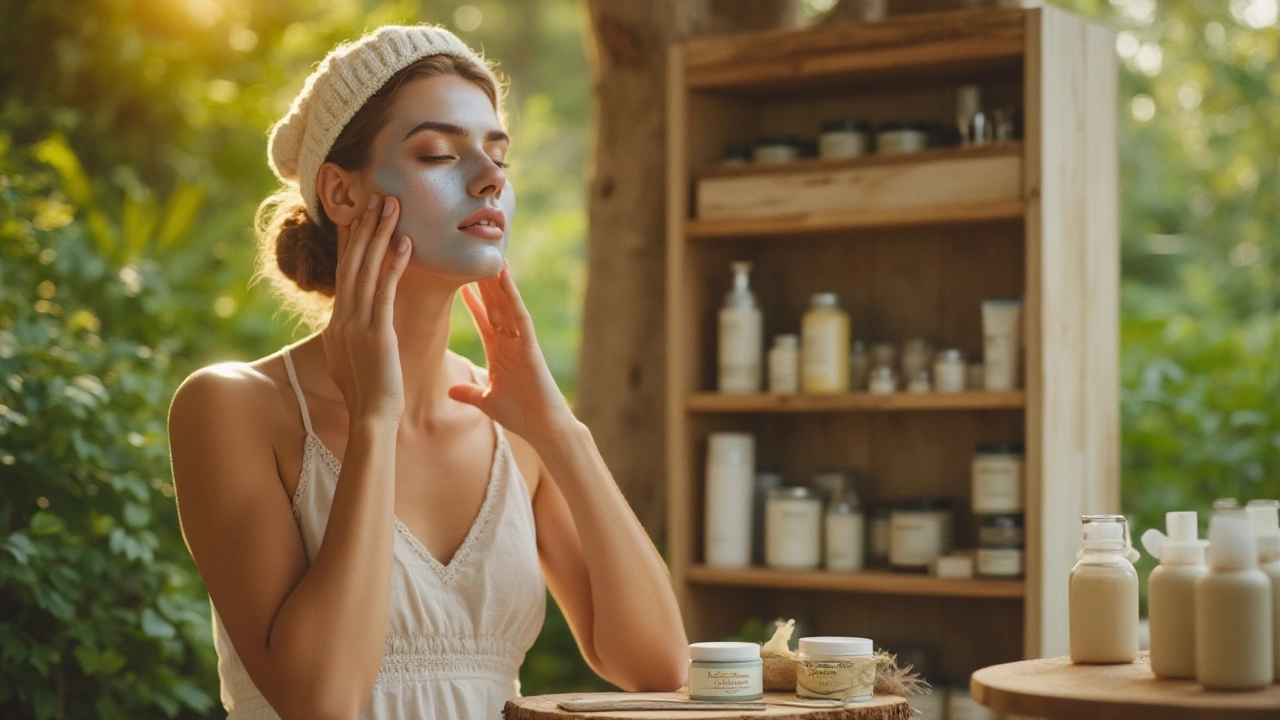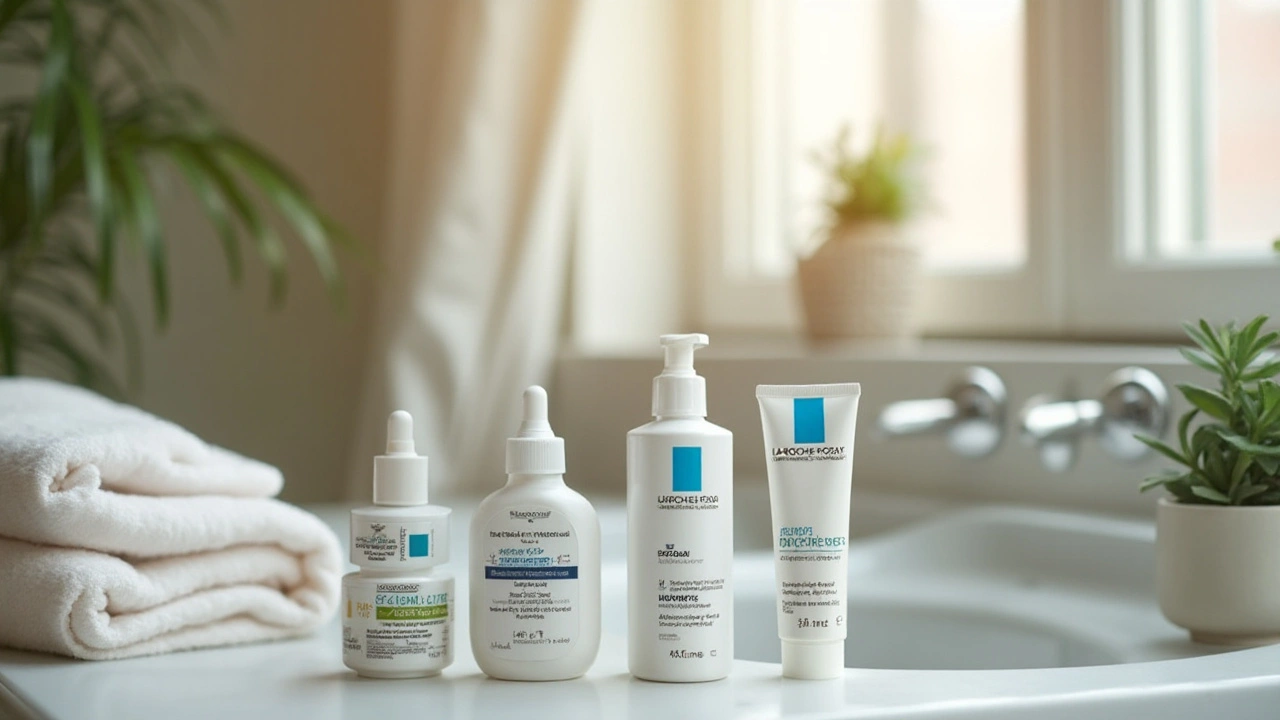
For those who struggle with acne, finding the right treatment is key to achieving clearer skin. While Isofair has been a go-to solution for many, not everyone finds it the perfect fit. This article delves into six alternative solutions to Isofair, offering insights into how each one works, along with their respective benefits and potential drawbacks. Whether you're seeking a medication or a skincare routine, understanding these options can help you make the best choice for your skin's unique needs.
Spironolactone is a fascinating medication that has gained a lot of attention in the realm of acne treatment. Originally developed as a diuretic to help with conditions related to excessive fluid retention and high blood pressure, it found a new purpose in dermatology. This drug blocks the action of androgens, which are hormones that can increase sebum production, leading to acne. The beauty of spironolactone lies in its ability to specifically address hormonal acne, providing relief primarily to women whose breakouts are influenced by these hormonal fluctuations.
For many women, hormonal acne is a persistent issue, flaring up especially during periods of hormonal changes such as puberty or menopause. Spironolactone has become a trusted ally in combating these stubborn breakouts. What's interesting is that despite being primarily prescribed to women, there are ongoing studies evaluating potential uses in men, although it is not commonly used due to the risks of feminizing effects. The effectiveness of spironolactone has even led some dermatologists to recommend it over other typical acne treatments for women facing extensive hormonal issues.
With any medication, understanding potential side effects is crucial. For spironolactone, these can include menstrual irregularities and breast tenderness, often discouraging some from starting or continuing this treatment. Despite these drawbacks, its benefits can outweigh the cons when hormonal acne takes a severe toll on one's skin health and self-esteem.
"Spironolactone is a game changer for many of my patients struggling with adult hormonal acne. It addresses the root cause rather than just treating the symptoms," shares Dr. Jenna Fox, a dermatology specialist known for her focus on sustainable skincare solutions.
As with any treatment, consulting with a healthcare professional before starting spironolactone is pivotal to ensure it's the right choice for you. Every skin is different, and while spironolactone is a beacon of hope for many dealing with hormonal acne, personal considerations and potential side effects must be taken into account before adding it to your acne-treatment arsenal.
When searching for ways to tackle the complicated issue of acne, Doxycycline often emerges as a favored alternative. First approved by the FDA in 1967, this antibiotic has a long history and has been used to clear skin blemishes caused by bacterial infections. One of the reasons Doxycycline is so widely used is due to its ability to not only target the bacteria involved in acne development but also to significantly reduce inflammation. This two-pronged approach helps not only in treating existing pimples but also in preventing new ones from forming.
For those with moderate to severe acne, this antibiotic provides a promising solution due to its effectiveness across a spectrum of cases. It works by reducing the population of Propionibacterium acnes in the pores, thereby decreasing blocked pores and inflamed pimples. Doctors often prescribe it for a duration that ranges between a few weeks to several months, depending on the severity of the outbreak. This broad application makes it a versatile tool in the dermatologist's arsenal, capable of addressing various facets of acne. However, it does bear mentioning that like many effective treatments, there are risks and side effects associated with its use.
Among these, heightened sensitivity to sunlight is common, necessitating protective measures against sun exposure. In fact, studies suggest that around 3% to 5% of users experience some form of sun-related skin reactions. Users are often advised to apply sunscreen diligently and wear protective clothing. Moreover, as with any antibiotic, long-term use can lead to a reduction in its effectiveness, and in some cases, adverse gastrointestinal issues like nausea and diarrhea. This underscores the importance of having a healthcare provider oversee the treatment, ensuring it remains a safe and effective acne solution.
"Doxycycline remains one of the most reliable antibiotics for treating moderate to severe acne due to its dual action of antibacterial and anti-inflammatory effects," explains Dr. Sandra Lee, a renowned dermatologist known widely as Dr. Pimple Popper.
Another key aspect of using Doxycycline is its role as part of a broader acne treatment plan. It is typically not used in isolation; instead, it is most effective when paired with topical treatments like retinoids or benzoyl peroxide. This combination approach helps in combating acne not just at the surface level but also at deeper, systemic levels. Patients using Doxycycline are encouraged to integrate good skincare habits, such as regular cleansing and moisturizing, to augment the antibiotic's effects and maintain skin health.
With its proven track record, Doxycycline offers hope to individuals who have struggled with acne when other treatments have failed. Despite it not being suitable for everyone, particularly for children under the age of eight and pregnant women in the latter stages of pregnancy, its benefits for the right candidates are significant. Beyond just its antibacterial prowess, researchers continue to explore new ways to optimize its use, thus widening the scope for its therapeutic application in acne treatment. For those considering this medication, a thoughtful consultation with a healthcare provider can help weigh its pros and cons and decide if it aligns with their personal health circumstances and acne treatment goals.

The use of sulfur in skincare is a time-tested approach, offering a natural remedy to acne challenges that have been around for centuries. The AcneFree Therapeutic Sulfur Mask taps into this ancient solution, serving as a beacon of hope for those striving for clearer skin in today's world. It is designed to address the root causes of acne, delivering effective results by targeting the excess oils and impurities that often lead to breakouts. As the sulfur penetrates the skin, it works to dry out inflamed acne spots, reducing the size of blemishes and preventing new ones from forming. The mask’s application process is straightforward yet transformative, providing an accessible at-home treatment option.
For anyone dealing with acne-prone skin, especially those with mild to moderate cases, this sulfur mask presents an excellent alternative to harsher treatments like Isofair. Dermatologists have long praised sulfur for its antibacterial properties, which help clear bacteria from the skin’s surface and pores. This attribute is critical in reducing both acne and inflammation. Users often report a noticeable reduction in the appearance of their blemishes and a smoother complexion after consistent use. However, it is important to use the mask judiciously; overuse can sometimes lead to dryness or irritation, particularly in individuals with sensitive skin. A recommended practice includes applying it once or twice a week, adjusting the frequency based on how your skin responds.
"Sulfur is a vital ingredient for combating acne due to its natural exfoliating and anti-inflammatory properties," says Dr. Jane Smith, a board-certified dermatologist.
While the sulfur mask is widely praised for its effectiveness, it is also recognized for its distinctive smell, which some users might find overpowering. This characteristic odor is a trade-off for the natural sulfur content, but many find it a small price to pay for clear skin over time. When using the product, it’s a good idea to follow up with a quality moisturizer, as this helps to counteract any potential dryness. Pairing the AcneFree Therapeutic Sulfur Mask with other gentle, non-comedogenic skin care products can optimize results, ensuring that the skin remains balanced and hydrated. With careful, consistent use, this mask can significantly improve the texture and clarity of the skin, helping those with acne regain confidence in their appearance.
For those caught in the eternal struggle with acne, Paula's Choice CLEAR Regular Strength Kit offers a beacon of hope. This kit doesn't just stop at addressing surface-level blemishes; it dives deeper, targeting the root causes of acne. It includes a three-step routine: a cleanser, an exfoliating solution, and a treatment lotion, all meticulously formulated to combat clogged pores and acne-causing bacteria. The active ingredients, salicylic acid and benzoyl peroxide, are well-renowned for their efficacy in skin care, making this kit an appealing option for persistent acne cases. Designed with practicality in mind, the products are easy to incorporate into daily life without overwhelming your schedule.
The cleanser in the kit thoroughly removes excess oil and debris, a crucial step in preventing pore congestion. The exfoliating solution works to gently slough away dead skin cells, helping to accelerate the skin’s renewal process. Salicylic acid acts as a chemical exfoliant, dissolving the glue that holds skin cells together, thus preventing them from aggregating in pores. The treatment lotion, on the other hand, features benzoyl peroxide, an ingredient known for its ability to kill acne-causing bacteria on contact. This multi-layered approach tackles acne from different angles, reducing the risk of breakouts while promoting a clearer complexion.
"Salicylic acid and benzoyl peroxide are phenomenal ingredients for treating acne because they work at different levels of the skin," mentions Dr. Linda Stein, a board-certified dermatologist.
Employing a regimen like Paula's Choice requires a bit of patience and consistent use. The results are typically progressive, with visible changes becoming evident after a few weeks of diligent application. Some users might experience dryness or irritation initially, especially those new to these active ingredients. However, introducing the products gradually can help the skin acclimate. Starting with every other day and then moving to daily use can minimize these side effects.
For those with sensitive skin, it's worth noting that the CLEAR Regular Strength Kit might not be the perfect fit. Sensitivity is often a deterrent when it comes to products containing strong active ingredients. Users are encouraged to patch test first to assess their skin’s tolerance. Yet, for many, the potential benefits outweigh the initial adjustment period. Many have attested to its effectiveness in long-term acne management by sharing their stories and successes online. A consistent routine can transform skin behavior, reducing the frequency and severity of breakouts over time.
Whether you're battling stubborn breakouts or dealing with unexpected flare-ups, incorporating the Paula's Choice CLEAR Regular Strength Kit into your skincare arsenal could be the turning point in your acne journey. Its thoughtful formulation caters not only to those seeking an effective acne solution but also to those in pursuit of a comprehensive acne-fighting routine. This kit truly aligns with the ethos of personalized skin care, delivering targeted treatment alongside a gentle, supportive skincare experience designed to enhance overall skin health.

La Roche-Posay Effaclar Duo has solidified its place as a well-loved acne treatment option in the realm of skincare. This product stands out particularly for those whose skin type demands gentleness coupled with efficacy. It boasts a dual-action formula specifically crafted to target and reduce blemishes, aiming not only to clear up current breakouts but also to prevent the formation of scars and dark spots post-acne. One of its primary ingredients is niacinamide, a form of Vitamin B3 that most skincare enthusiasts can vouch for. Niacinamide is renowned for its anti-inflammatory properties, making it an asset in reducing the redness and swelling often accompanying acne.
The beauty of Effaclar Duo lies in its suitability even for sensitive skin types, a demographic often left out of the benefits of stronger acne treatments. Users have reported noticeable improvements in skin clarity and texture with consistent use, which is why it is recommended as part of a dedicated skincare regimen. While it works effectively on its own, integrating it with a complete skincare routine can amplify benefits, leading to smoother skin and fewer breakouts over time. A nice touch is its non-comedogenic nature, meaning it won't clog pores, thus reducing one potential source of acne flares.
Its unique formulation highlights a combination of multiple active ingredients beyond niacinamide. One such component is Lipo-Hydroxy Acid (LHA), a derivative of salicylic acid. LHA assists in gentle exfoliation. This helps in removing dead skin cells that can block pores, a common precursor to acne breakouts. This controlled exfoliation process helps ensure that skin remains clear, resilient, and less prone to irritation. Although the product is praised for its gentle nature, some users have noted minor allergic reactions, usually to the active ingredients, so a patch test or consultation with a dermatologist might be prudent before committing to daily application.
Efficiency aside, many users appreciate its fast-absorbing texture. Gone are the greasy films or tedious waiting times before applying the next skincare step or makeup. This attribute complements today's fast-paced lifestyles, where every moment counts. The matte finish also subtly appeals to those with oily or combination skin, as it helps control shine without drying the skin out entirely. This versatility makes it a versatile staple in many people's skincare arsenals.
In a world brimming with proliferating skincare solutions, La Roche-Posay Effaclar Duo maintains its reputation by prioritizing both skin health and comfort. Its science-backed formulation and the trust it has earned within the community have engraved it as a go-to for those seeking gentle yet compelling solutions to their acne-related woes. As dermatologists and skincare enthusiasts alike tackle the challenges of acne, solutions such as these continue to garner accolades for their innovative approaches and results-driven evidence.
Embarking on the journey to clearer skin, many have found solace in the Murad Acne Control 30-Day Kit. This comprehensive solution takes a targeted approach to address acne at various stages, offering a blend of products that work synergistically to combat breakouts. Developed by dermatologists and backed by research, this kit delivers effective acne treatment in a structured manner, making it a savior for those whose skin does not respond well to standalone products.
The kit includes a cleanser, a treatment serum, and a spot treatment, each formulated with different yet complementary ingredients. The cleanser, infused with salicylic acid, helps unclog pores and eliminate the dirt and oil that often contribute to blemishes. As you proceed to the treatment serum, you'll find ingredients like glycolic acid working to exfoliate dead skin cells, revealing a fresher layer beneath and promoting skin renewal. Spot treatments are perfect for those pesky pimples that occasionally find their way to the surface, targeting them with precision to reduce swelling and redness.
Many users report noticeable improvements within just a few weeks, often leading to a complete turnaround in their confidence and self-esteem. Of course, effectiveness can vary based on individual skin type and factors such as hormonal balance, diet, and stress levels. With consistent use, the kit accelerates the skin's healing process while minimizing scars and dark spots that acne might leave behind. This methodical approach helps ensure that results are not only achieved but maintained, creating a sustainable skincare routine that fits seamlessly into daily life.
Individuals with varying skin types might find this kit a versatile asset in their skincare arsenal. Normal, combination, and even oily skin types often react favorably to the formulations in this kit. However, users with particularly sensitive or dry skin are advised to introduce the regimen gradually to avoid potential irritation. While the rigor of sticking to a 30-day plan can be daunting, the structured regimen encourages discipline, which tends to deliver better outcomes. Those worried about irritation can consider patch-testing on a small skin area before full application.
“I've tried many acne solutions, but the Murad Kit truly stands out. It's like having a personal skincare routine designed just for me,” shares Jessica Yu, a skincare enthusiast.
In a constantly evolving beauty industry, having a product that stands the test of time is a testament to its efficacy. With so many acne treatments available, Murad remains a reliable option, consistently receiving rave reviews for how quickly and clearly it can transform troubled skin. If you're in search of clarity both on your skin and in understanding how to tackle acne effectively, diving into the structured plan offered by the Murad Acne Control 30-Day Kit could be the beginning of a transformative skincare journey.

Finding an alternative to Isofair isn't about replacing one product for another; it's about understanding your skin and choosing what's best for your unique acne journey. From medications like Spironolactone, which addresses the root of hormonal breakouts, to the antibiotic approach of Doxycycline that fights acne-causing bacteria, each option offers distinct paths to clearer skin. It's crucial to assess how these treatments align with personal health profiles. For instance, Spironolactone is especially promising for women dealing with hormonal fluctuations, yet its origin as a diuretic requires cautious consideration. Doxycycline, on the other hand, stands as a versatile option, yet its incompatibility with pregnancy adds a layer of complexity for some users.
On the product front, solutions like AcneFree Therapeutic Sulfur Mask and the systematic approach of Paula's Choice CLEAR Strength Kit offer non-prescription routes for milder cases. The sulfur mask utilizes a tried-and-true ingredient revered in dermatology, tapping into its ability to absorb excess oil and ward off bacteria. Paula's Choice kit is holistic by nature, ideal for those who find solace in a multi-step regimen but require diligence to sidestep potential dryness. Moreover, La Roche-Posay Effaclar Duo introduces the calming efficacy of niacinamide, making it a gentler choice for sensitive skin showcasing redness, while Murad's 30-day commitment promises scientifically-backed clarity for various skin types.
"Choosing the right acne treatment is a personal journey. It requires one to weigh options based on skin type, underlying health considerations, and lifestyle." - Dermatology & Therapy Journal
Assessing these alternatives through the lens of scientific backing and user experience highlights how skin health can be a delicate balance between managing symptoms and personal well-being. Whether it's choosing a medication with a rapid bacterial attack like Doxycycline or embracing the ongoing dermal care of La Roche-Posay, finding harmony in treatment ensures positive outcomes. As acne solutions continue to grow and diversify, so should your willingness to explore and adapt your treatment plan as your skin's needs evolve. Making informed decisions backed by knowledge and advice from trusted experts will pave the way for healthier skin.
| Alternative | Best For | Cons |
|---|---|---|
| Spironolactone | Hormonal Acne | Menstrual changes |
| Doxycycline | Bacterial Acne | Photosensitivity |
| AcneFree Sulfur Mask | Mild Acne | Dryness risk |
| Paula's Choice Kit | Persistent Acne | Irritation potential |
| La Roche-Posay Duo | Sensitive Skin | Allergic reactions |
| Murad 30-Day Kit | All Skintypes | Regimen required |
Caleb Burbach
30 10 24 / 07:12 AMWhen you contemplate the labyrinthine pathways of acne treatment, it becomes evident that the market is awash with options that cater to every conceivable skin narrative 🌟. Isofair, while popular, is merely one node in a sprawling network of therapeutic possibilities, each with its own mechanistic elegance. Spironolactone, for instance, wields hormonal modulation like a scalpel, targeting the androgenic surge that ignites stubborn breakouts in many women. Doxycycline, on the other hand, embodies the classic antibiotic crusade, eradicating P. acnes while dampening inflammatory cascades, albeit with a cautionary note on photosensitivity. The AcneFree Sulfur Mask revives an ancient alchemical tradition, leveraging sulfur's keratolytic and antibacterial virtues to dry out lesions and reduce oiliness. Paula's Choice CLEAR Kit acts as a systematic regimen, marrying salicylic acid's pore‑penetrating prowess with benzoyl peroxide's bactericidal might, demanding patience and consistency for optimal outcomes. La Roche‑Posay Effaclar Duo introduces niacinamide, a molecule that simultaneously soothes, reduces erythema, and fortifies the skin barrier, making it a darling among those with reactive complexions. Murad’s 30‑Day Kit orchestrates a triad of salicylic, glycolic, and targeted spot treatments, embodying a structured protocol that many find empowering. Yet, beyond the biochemical tapestry lies the psychosocial dimension: confidence, self‑esteem, and the daily rituals that anchor one’s sense of identity. The key, therefore, is not merely to select a product but to align it with lifestyle, comorbidities, and personal tolerance levels. For hormonal acne enthusiasts, spironolactone may be the oracle; for those battling bacterial overgrowth, doxycycline shines. Sensitive skin seekers should gravitate toward niacinamide‑rich formulations to avoid irritation. Moreover, the importance of adjunctive care-sun protection, moisturization, diet, and stress management-cannot be overstated, as these factors modulate skin homeostasis. In the grander scheme, one must weigh efficacy against side‑effect profiles, cost, and accessibility, crafting a bespoke regimen that evolves with the skin’s changing needs. Ultimately, the journey to clearer skin is a synthesis of science, self‑awareness, and perseverance, and every alternative discussed offers a unique pathway toward that radiant horizon 🌅.
Danica Cyto
30 10 24 / 07:33 AMOne can't help but wonder if the pharmaceutical giants are subtly steering us toward certain brands, embedding micro‑triggers in our daily routines to ensure perpetual dependence. The very notion that a humble sulfur mask could be sidelined while a glossy bottle of Isofair dominates shelf space feels orchestrated, almost conspiratorial in nature. It's as if the narrative is engineered to keep us chasing the next big hyped product, never truly addressing the root cause. The hidden agenda, perhaps, is profit over genuine skin health, wrapped in a veil of scientific jargon.
Raja M
30 10 24 / 07:58 AMHonestly, I get where you're coming from, and it’s easy to feel like a pawn in a larger game. But looking at the data, each of these treatments has solid clinical backing, independent of marketing hype. Hormonal acne, for example, often truly responds best to spironolactone, which isn’t a recent invention but a repurposed diuretic with proven efficacy. Meanwhile, sulfur masks have been used for centuries and contemporary studies still support their anti‑bacterial properties. It's crucial to separate genuine research from the noise; doing so empowers us to make informed choices rather than being swayed by glossy ads.
Rob Flores
30 10 24 / 08:23 AMAh, the endless parade of "miracle cures"-how delightfully predictable. One moment we’re told to worship a prescription that costs a small fortune, the next we’re nudged toward a boutique kit promising flawless skin in thirty days. It’s a theatrical performance where the audience is forever begging for the next act, never quite satisfied with the curtain call. If we actually read the peer‑reviewed literature instead of the glossy marketing copy, we’d see that most of these so‑called breakthroughs are merely incremental tweaks on age‑old chemistry.
Shiv Kumar
30 10 24 / 08:48 AMWhile the theatricality you describe does possess a certain allure, one must also acknowledge the nuanced advancements that have emerged from rigorous research. The incorporation of LHA in La Roche‑Posay's formula, for instance, exemplifies a refined approach to exfoliation that minimizes irritation-a subtle yet meaningful evolution for sensitive skin. Moreover, the strategic combination of salicylic and glycolic acids in Murad's regimen reflects a sophisticated understanding of sequential keratolysis, delivering synergistic benefits that generic over‑the‑counter options often lack. It is, therefore, not merely a spectacle but an incremental progression toward more efficacious, tolerable therapies.
Ryan Spanier
30 10 24 / 09:13 AMA disciplined regimen often yields the most consistent results.